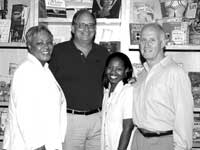
Principals Tell All to Scholastic
by Sybil Maimin
In an on-going effort to connect
with its base and find out how best to serve it, Scholastic,
the world’s
largest producer of educational materials, has established
a Principal Fellows Program. Modeled after the successful
six-year old Teacher Fellows Program, the new initiative
brought three highly experienced public school principals
to Scholastic’s New York headquarters in July for
an intensive five-day series of meetings with company
executives and division heads who wanted baseline input
on the evolving education scene. Fellows were Merian
Stewart of Noyes Elementary School in Altadena, California,
Les Potter of Silver Sands Middle School in Port Orange,
Florida, and Patricia Welch of Hillcrest High School
in Country Club Hills, Illinois. Each was impressed with
the program and particularly welcomed the unusual opportunity
to interact with principals from schools whose grade
levels were different from their own. Unlike a typical,
large national conference, the small number of participants
meant, “We were able to craft the discussion. We
could spin off of each other’s responses,” reported
Stewart. What they discovered is that on all levels and
in all locations, “Test score improvement and standards
are huge. You can’t go anywhere without hearing
about standards.” The No Child Left Behind Act
(NCLB) is presenting a big challenge. All echoed Potter,
who explained, “We like standards and achievement.
What we don’t like is the way they look at statistics.” In
his school of 1400 students, the score in one of 32 categories
rated (involving 10 underperforming youngsters) was deficient,
resulting in a failing grade for the school. “It’s
almost like the Federal government is playing, ‘I
gotcha.’ I already know certain kids are not doing
well and we are working hard to improve that. I don’t
need tests to show me what I already know.” While
at the program, Welch wrote an article about NCLB for
Scholastic. “I agree with the philosophy,” she
says, but it’s where we start that matters. We
are expected to bring students from 5th grade
level to 11th grade level in just 2 years.
We can track and show improvement, but if not at the
expected level, the school is placed on a list…it
will make or break you.” She suggests encouraging
legislators to look at the law and enact alternate ways
to measure student progress.
The Fellows shared best practices
and experiences. In motivating staff, leadership must
not come solely from the principal. Start with a small
number of teachers who are empowered by being given
chairs or other special responsibilities, and “they will infect others.” The
role of the principal hasn’t changed much, reported
Welch. “We’re expected to be cheerleaders
for our school…be positive and creative. When
teachers are happy, students are happy—then parents
are happy.” Reading is now taught at all levels,
including reinforcement in high school, using reading
blocs geared to specific competencies. “We are
in an accountability era,” said Stewart. “Everything
is based on test scores. We can have a clean, safe campus,
but that’s not what gets highlighted.” Potter
noted a trend of combining elementary and middle schools
(K-8), challenging old notions of separation of age groups.
The Fellows visited PS 20,
a highly regarded New York City public elementary school,
and its principal, Dr. Leonard Golubchick. Impressions
varied. Stewart was “amazed
that there wasn’t grass for the children to play
on,” and that “it was embedded in the heart
of a business district.” Potter noted that the
building is 100 years old and shows much wear and tear.
He prefers the campus-like setting and newness of his
institution. What Welch saw was an “upscale, magnet
elementary school” where “the students were
focused on learning.” From PS 20, she learned the
technique of using pupil-led oral storytelling as a segue
to good story writing.
With emphasis on standards
and testing, the educational landscape has changed.
In meeting with each other, the principals discovered, “we are all in the same
boat.” Scholastic also recognizes there are new
needs to be met, and the principals expressed appreciation
for being consulted in the planning—“a win,
win situation,” exclaimed Potter.#
